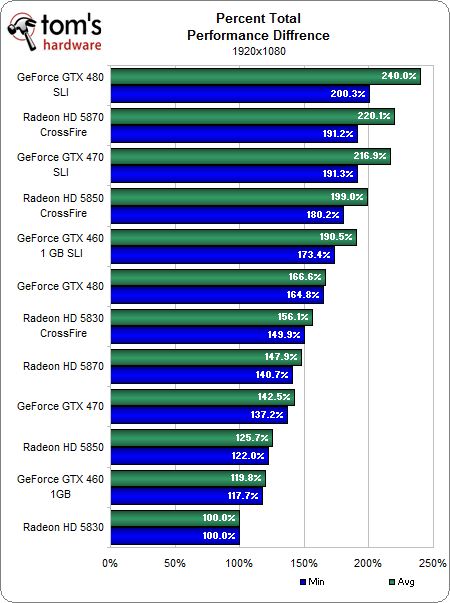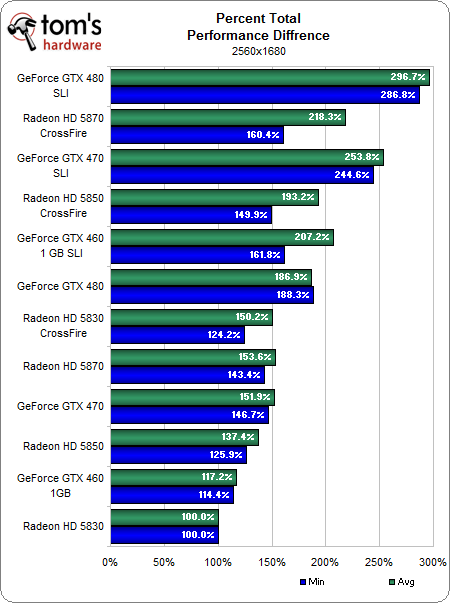AMD CrossFire Vs. Nvidia SLI Scaling Analysis
We’ve seen impressive performance from Nvidia's GeForce GTX 460 when it's matched up with a second card in SLI mode. But how does the entire high-end GeForce GTX 400 line compare to Radeon HD 5000-series cards? We test them all in several popular games.
Conclusion
Remember, we’ve organized this chart by listing average prices from the lowest on the bottom to the highest on top. At 1920x1080, it appears that CrossFire and SLI performance scales right along with price. Of course, the spread between certain graphics cards is quite close--the most notable example is the GeForce GTX 470 that can be purchased for right around $280, while the 5850s are going for about $260 now.
In general, the lower-end GeForce GTX 400 cards are putting solid pressure on the competing Radeon solutions, and as a result, we've already seen a noticeable Radeon HD 5000 series price drop to keep the AMD cards in line with the competitor’s price/performance ratios.
At 2560x1600, we see a definite performance drop from the Radeon cards in CrossFire. As we mentioned in the benchmarks, at least some of the blame for this can be attributed to the 1 GB frame buffer on Radeon cards while the competing GeForce GTX 470 and GeForce GTX 480 have 1280 MB and 1536MB, respectively, giving them breathing room when it comes to high resolutions mixed with demanding AA settings. In single-card configurations, the Radeons don’t seem to mind the RAM deficit. But in CrossFire, these cards certainly seem to be experiencing some kind of RAM-related bottleneck when pushed hard.
Frankly, there aren’t a lot of 2560x1600 monitors out there in the wild, so this probably isn’t a major concern for most folks. But for gamers planning on a high-resolution 30” monitor or a triple-monitor gaming rig, GeForce GTX 470/480 cards or Eyefinity Edition Radeon cards with 2 GB of RAM will be something to look into.
We hope to revisit the 2560x1600 resolution performance with 2 GB Radeon cards in CrossFire to see if more video RAM clears up the inconsistency. For those of you running 1920x1200 or lower resolutions, there is a lot less to worry about when putting together your hardcore gaming rig.
Get Tom's Hardware's best news and in-depth reviews, straight to your inbox.
Don Woligroski was a former senior hardware editor for Tom's Hardware. He has covered a wide range of PC hardware topics, including CPUs, GPUs, system building, and emerging technologies.
-
jrharbort Nvidia wins this war thanks to the larger standard framebuffer. ATI needs to pick up in this area a bit, as 1GB framebuffers have been around for a while now. Looking foward to another article based on the next gen cards a few months from now. Should be interesting. =)Reply
Good job to both ATI and Nvidia on this generation. -
gordo_46 ReplyBUT.. i would have preferred 2-3 way SLI with GTX460's.
gtx 460 can only do 2 way sli -
gkay09 The SLI scaling is one place where Nvidia wins almost all the time, but ATI has improved a lot though, it still need to work harder if they want to have a complete win over Nvidia...Reply -
gordo_46 yeah it a shame that it can only do 2 way sli. We would get 3 way gtx 470 sli level performance at amd radeon power consumptionReply -
Nice article. I've made some charts, based on the data in this article, that reflect SLI and CrossFireX scalings. Nvidia's victory is clear cut at 2560 x 1600.Reply
1920x1200
http://www.imagebam.com/image/741eca102680169
2560x1600
http://www.imagebam.com/image/0295fe102680172
Also, when it comes to GPU discussions, the comment sections of Tom's and Fudzilla are swarmed by fanboys of 1 certain team. (Can you tell which? It's already obvious here, but much more so at Fudzilla.) Competition is good. Don't downrank comments just because they favor the "other" team.
-
Twoboxer 12 million people with WoW subscriptions, new expansion due 12/7/10, lot's of vid cards being bought for that purpose . . . I know its not easy, the format may have to be different, but can you guys consider including WoW in the benching runs?Reply


